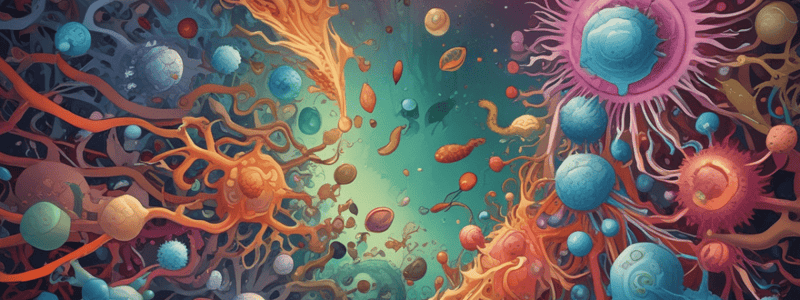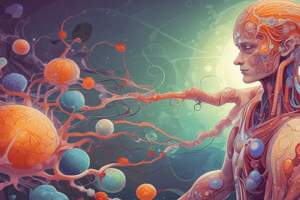Podcast
Questions and Answers
Which of the following cells is a type of phagocyte?
Which of the following cells is a type of phagocyte?
- B lymphocytes
- T lymphocytes
- Neutrophils (correct)
- NK cells
What is the main function of dendritic cells in the immune response?
What is the main function of dendritic cells in the immune response?
- To produce antibodies
- To directly kill infected cells
- To link innate and adaptive immune responses (correct)
- To become memory cells
Which cells are described as large granular lymphocytes?
Which cells are described as large granular lymphocytes?
- Monocytes
- NK cells (correct)
- Neutrophils
- Macrophages
Which of the following statements about macrophages is true?
Which of the following statements about macrophages is true?
Which of the following cell types are correctly matched with their roles in the immune response?
Which of the following cell types are correctly matched with their roles in the immune response?
Which component is part of the innate immune system and is always active?
Which component is part of the innate immune system and is always active?
What is a characteristic feature of the innate immune system recognition?
What is a characteristic feature of the innate immune system recognition?
What is an example of a cell-associated pattern recognition receptor (PRR) in the innate immune system?
What is an example of a cell-associated pattern recognition receptor (PRR) in the innate immune system?
Which type of molecule can recognize microbial pathogens in the innate immune system?
Which type of molecule can recognize microbial pathogens in the innate immune system?
Which of the following functions is NOT associated with innate immunity?
Which of the following functions is NOT associated with innate immunity?
Which of the following is an example of a physical barrier in the innate immune system?
Which of the following is an example of a physical barrier in the innate immune system?
What are pathogen associated molecular patterns (PAMP) recognized by?
What are pathogen associated molecular patterns (PAMP) recognized by?
What is the role of mannose binding lectin (MBL) in the innate immune system?
What is the role of mannose binding lectin (MBL) in the innate immune system?
Which of the following statements is true about intraepithelial lymphocytes?
Which of the following statements is true about intraepithelial lymphocytes?
What role do cilia play in the respiratory tracts?
What role do cilia play in the respiratory tracts?
Which of the following is true about lysozymes?
Which of the following is true about lysozymes?
What is the primary purpose of defensins in the immune system?
What is the primary purpose of defensins in the immune system?
Which of the following body sites typically has an acidic pH due to the action of lactobacillus?
Which of the following body sites typically has an acidic pH due to the action of lactobacillus?
How do normal bacterial flora act as a biological barrier?
How do normal bacterial flora act as a biological barrier?
What forms after lysosomal granules fuse with the phagosome?
What forms after lysosomal granules fuse with the phagosome?
What is the primary mechanism of the oxygen-dependent system in phagocytosis?
What is the primary mechanism of the oxygen-dependent system in phagocytosis?
Which enzyme is produced in the oxygen-independent system?
Which enzyme is produced in the oxygen-independent system?
What shape is formed by the plasma membrane during phagocytosis?
What shape is formed by the plasma membrane during phagocytosis?
Which of the following is NOT converted into reactive oxygen species in the oxygen-dependent system?
Which of the following is NOT converted into reactive oxygen species in the oxygen-dependent system?
Which organisms are adapted to grow in phagocytes?
Which organisms are adapted to grow in phagocytes?
What is the main function of phagocytes in response to invading microorganisms?
What is the main function of phagocytes in response to invading microorganisms?
During the chemotaxis and migration phase, which cells are actively recruited to the site of infection?
During the chemotaxis and migration phase, which cells are actively recruited to the site of infection?
What is the role of PRRs (pattern recognition receptors) on phagocytes?
What is the role of PRRs (pattern recognition receptors) on phagocytes?
What enhances the process of attachment and ingestion of microbes by phagocytes?
What enhances the process of attachment and ingestion of microbes by phagocytes?
What is formed after a phagocyte engulfs a microbe during the ingestion process?
What is formed after a phagocyte engulfs a microbe during the ingestion process?
Which mechanism involves highly reactive molecular oxygen species to destroy microbes?
Which mechanism involves highly reactive molecular oxygen species to destroy microbes?
What role do neutrophils play in the oxygen-independent mechanism?
What role do neutrophils play in the oxygen-independent mechanism?
What is the term for the process of coating microbes to target them for phagocytosis?
What is the term for the process of coating microbes to target them for phagocytosis?
Which serum proteins are involved in the alternative pathway of complement activation?
Which serum proteins are involved in the alternative pathway of complement activation?
Which cytokine is responsible for macrophage activation?
Which cytokine is responsible for macrophage activation?
What is the function of interferons released from virus-infected cells?
What is the function of interferons released from virus-infected cells?
TNF-α, IL-1, IL-6, and chemokines are primarily classified as which type of cytokines?
TNF-α, IL-1, IL-6, and chemokines are primarily classified as which type of cytokines?
Which factor determines why N. gonorrhea only infects humans?
Which factor determines why N. gonorrhea only infects humans?
Which cytokines are involved in the control of inflammation?
Which cytokines are involved in the control of inflammation?
Which characteristic of adaptive immunity allows it to differentiate between own body cells and foreign substances?
Which characteristic of adaptive immunity allows it to differentiate between own body cells and foreign substances?
What type of immunity is developed when the body is exposed to a foreign antigen and produces its own antibodies?
What type of immunity is developed when the body is exposed to a foreign antigen and produces its own antibodies?
Which form of immunity is typically transferred through breast milk?
Which form of immunity is typically transferred through breast milk?
Which characteristic of adaptive immunity is responsible for a stronger immune response upon re-exposure to the same antigen?
Which characteristic of adaptive immunity is responsible for a stronger immune response upon re-exposure to the same antigen?
What type of immunity is provided by the transfer of readymade antibodies?
What type of immunity is provided by the transfer of readymade antibodies?
What is the role of complement proteins in the immune response?
What is the role of complement proteins in the immune response?
How do macrophages recognize antigens during phagocytosis?
How do macrophages recognize antigens during phagocytosis?
Which of the following is a role of acute-phase proteins?
Which of the following is a role of acute-phase proteins?
Which factor does NOT influence the spread of an infection?
Which factor does NOT influence the spread of an infection?
What is a common reason why some individuals are more susceptible to leprosy?
What is a common reason why some individuals are more susceptible to leprosy?
Which strain of bacteria is known for causing a highly contagious disease, as indicated in the content?
Which strain of bacteria is known for causing a highly contagious disease, as indicated in the content?
What is the role of C3b in phagocytosis?
What is the role of C3b in phagocytosis?
Which protein is associated with the inflammatory response and activation of complement during an infection?
Which protein is associated with the inflammatory response and activation of complement during an infection?
Flashcards are hidden until you start studying
Study Notes
Innate Immunity
- Innate immunity is the resistance an individual has by birth, providing immediate defense against infections
- Components of innate immunity include physical barriers, chemical barriers, and biological barriers
Function of Innate Immunity
- Prevents, controls, or eliminates infection of the host
- Stimulates adaptive immune response
Features of Innate Immune Recognition
- Recognizes structures characteristic of microbial pathogens (Pathogen Associated Molecular Patterns, PAMPs)
- Recognizes microbial products essential for survival
- Recognizes abnormal host cells
Recognition Molecules of Innate Immunity
- Cell-associated pattern recognition receptors (PRRs): Toll-like receptors (TLRs)
- Soluble recognition molecules: Pentraxins (C-reactive protein, CRP) and Collectins (mannose-binding lectin, MBL)
Components of the Innate Immune System
First Line of Natural Defense
- Physical barriers:
- Intact epithelial surfaces
- Lymphocytes (intraepithelial lymphocytes)
- Eye (tears and blinking reflex)
- Respiratory tracts (hair, mucous, and cilia)
- Chemical barriers:
- Acidic pH (skin, stomach, and vagina)
- Microbicidal action of secreted molecules (lysozymes and defensins)
- Digestive enzymes (saliva and small intestine)
- Biological barriers:
- Normal bacterial flora (supresses growth of pathogenic bacteria and fungi)
Second Line of Natural Defense
- Circulating effector cells:
- Phagocytes (neutrophils and macrophages)
- Natural killer (NK) cells
- Dendritic cells
- Phagocytosis of microbes:
- Chemotaxis and migration
- Recognition and attachment
- Ingestion
- Digestion or destruction
Ingestion
- Phagocytes recognize and attach to microbes through receptors
- Phagosome formation
- Lysosomal granule fusion
Digestion or Destruction of Ingested Microbes
- Oxygen-dependent system (reactive oxygen species)
- Oxygen-independent system (proteolytic enzymes)
Circulating Effector Proteins
- Complement system
- Acute-phase proteins (mannose-binding lectin, MBL, and C-reactive protein)
Inflammatory Response and Spread of Infection
- Factors that determine the spread of infection: species, race, microbe, and individual
- Inflammatory response: a complex sequence of events that limits the spread of infection
Interferon (INF)
- Released from virus-infected cells to inhibit viral spread to neighboring cells
Cytokines
- Part of innate immunity, involved in pro-inflammatory, anti-inflammatory, and immune responses
Factors that Determine Innate Immunity
- Species
- Races
- Individuals (health status, age, etc.)
Characters of Adaptive Immunity
- "Self" and "non-self" recognition
- Specificity
- Diversity
- Need prior exposure
- Memory (long-term immunity)
Types of Adaptive Immunity
- Passive immunity (readymade antibodies, temporary protection)
- Active immunity (body produces its own antibodies, long-lasting protection)
Studying That Suits You
Use AI to generate personalized quizzes and flashcards to suit your learning preferences.




